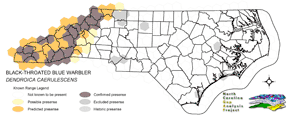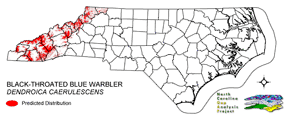
| Taxa: |
| Order: |
| Family: |
| Aves |
| Passeriformes |
| Parulidae |
| NatureServe Global Rank: |
| NatureServe State (NC) Rank: |
| G5 |
| S4B,SZN |
| Federal Status: |
| NC State Status: |
| --- |
| --- |


| Land Unit |
| US Fish & Wildlife Service |
| US Forest Service |
| US National Park Service |
| US Department of Defense |
| NC State Parks |
| NC University System |
| NC Wildlife Res. Com. |
| NC Forest Service |
| NC Div. of Coastal Mgmt. |
| Local Governments |
| Non-Governmental Org. |
| Other Public Lands |
| Private Lands |
| GAP Status 1-2 |
| All Protected Lands |
| Statewide |
| Hectares |
| 0.00 |
| 180,830.88 |
| 0.00 |
| 81,061.38 |
| 1,365.03 |
| 71.19 |
| 2,231.91 |
| 718.68 |
| 0.00 |
| 5,347.35 |
| 5,891.13 |
| 8.55 |
| 284,861.25 |
| 111,068.76 |
| 277,399.56 |
| 562,387.35 |
| Acres |
| 0.00 |
| 446,842.75 |
| 0.00 |
| 200,306.99 |
| 3,373.06 |
| 175.91 |
| 5,515.17 |
| 2,815.52 |
| 0.00 |
| 13,213.59 |
| 14,557.30 |
| 21.13 |
| 703,907.34 |
| 275,496.45 |
| 686,508.73 |
| 1,390,728.76 |
| % of Dist. on |
| Prot. Lands |
| 0.0 % |
| 65.2 % |
| 0.0 % |
| 29.2 % |
| 0.5 % |
| < 0.1 % |
| 0.8 % |
| 0.3 % |
| 0.0 % |
| 2.1 % |
| 2.1 % |
| 0.0 % |
| 0.0 % |
| 40.0 % |
| ----- |
| ----- |
| % of Dist. on |
| All Lands |
| 0.0 % |
| 32.2 % |
| 0.0 % |
| 14.4 % |
| 0.2 % |
| < 0.1 % |
| 0.4 % |
| 0.1 % |
| 0.0 % |
| 1.0 % |
| 1.0 % |
| < 0.1 % |
| 50.7 % |
| 19.7 % |
| ----- |
| ----- |
|
Common species in the mountains (Potter et al. 1980). Prefers heavy undergrowth (Harrison 1975) in the shrub layer in the interior regions (Dunn and Garrett 1997) of mature deciduous and mixed forests (Griscom and Sprunt 1957) and in the high elevation spruce-fir forests (Alsop 1991, Hamel 1992). Also nests in heath balds (Simpson 1992), old clearings, and logged areas (Curson et al. 1994), typically on mountain slopes and ridges (Dunn and Garrett 1997). It is also found in oak-pine woods and ravines forested by hemlocks (Dunn and Garrett 1997), often near a stream (Potter et al. 1980). Builds a nest 10 inches to 4 feet, and rarely up to 20 feet (Dunn and Garrett 1997), above the ground in the fork of a low tree or shrub or in weeds and ferns growing between rocks and fallen trees in well-wooded ravines (Harrison 1975, Potter et al. 1980). Forages on large interior branches in the lower half of trees (Alsop 1991), males generally higher than females (Dunn and Garrett 1997). NATURE SERVE GLOBAL HABITAT COMMENTS: Widespread throughout the Southern Appalachians over 1050 m; less numerous down to 750 m elevation (Hamel 1992). Understory of deciduous and mixed woodland, second growth, partially cleared forest; in migration also in other forest types, open woodland and scrub. In New Hampshire, used shrubs for both nesting and foraging, but nest-site requirements appeared to be most important in determining habitat selection (Steele 1993). In winter usually in dense forests in mountainous interiors of large islands, also in rich lowland forest (Jamaica, Lack 1976); in mature forest and shrubby second growth in Puerto Rico (Wunderle 1995). Nests in small tree, sapling, or shrub in dense undergrowth (e.g., hobblebush, mountain laurel, rhododendron), within about a meter of the ground. |
| Code | Name | Description | NC Natural Heritage Program Equivalent |
| 230 | Piedmont Mesic Forest | American Beech - Red Oak - White Oak Forests. | Mesic Mixed Hardwood |
| 384 | Piedmont/Mountain Mixed Bottomland Hardwood Forests | Includes temporarily to seasonally forests dominated by hardwood species. Hardwoods include sweetgum, red maple, sycamore which co-occur in a mosaic of bottomland and levee positions. Includes alluvial hardwood forests in the mountains. Hemlock and white pine may occur as inclusions, but are generally mapped separately. | Piedmont/Mountain Alluvial Forest, Piedmont/Mountain Levee Forest |
| 36 | Successional Deciduous Forests | Regenerating deciduous trees with a shrub stature. Commonly dominated by sweetgum, tulip poplars and maples. | No equivalent |
| 517 | Hemlock Floodplain Forest | Alluvial forest with hemlock and/or white pine in mountains and western piedmont. Hydrology is generally temporarily to seasonally flooded. | Canada Hemlock Forest |
| 521 | Spruce/Fir Forest | High Elevation Frazer-Fir - Red Spruce, Red Spruce and Red-Spruce-Yellow Birch Forests. Tree densities included here include both woodland to forest density. Highly intermixed with Northern Hardwoods, Grassy Balds, and Shrub Balds. | Red Spruce--Fraser Fir Forest, Fraser Fir Forest |
| 522 | Northern Hardwoods | High Elevation forests including yellow birch, American beech, and yellow buckeye. Includes forests with Hemlock and Yellow Birch. | Northern Hardwoods Forest, Boulderfield Forest |
| 524 | Shrub Bald | Variable phenologies, predominantly evergreen balds with rhododendon and Mountain laurels. Deciduous shrubs including green alder and Alleghany and smooth blackberry are included as well. Red Oak - Chestnut Oak Woodlands may be included in cases where the density of the woodland species is low and the shrub component is dense. | Heath Bald |
| 525 | Appalachian Oak Forest | A variety of oak forest types including Black, White, Scarlet Oaks in dry to mesic situations. Includes forests historically co-dominated by American Chestnut. | High Elevation Red Oak Forest, Montane White Oak Forest |
| 526 | Appalachian Cove Forest | Mixed Mesophytic forests of the mountains. Includes tuliptree, basswood, yellow buckeye and surgar maple. This class is mapped to include cove forests dominated or co-dominated by hemlock. | Rich Cove Forest, Acidic Cove Forest |
| 527 | Appalachian Hemlock | Upland hemlock forests of the moutains region. Vary from side slopes to steep slope positions. | Canada Hemlock Forest |
| 528 | Appalachian Xeric Pine Forest | Pine forests and woodlands on xeric sites. A variety of pines, including Virginia, Shortleaf, Eastern White Pine, Table Mountain and Pitch pine. Often small areas of dense pine within a matrix of Xeric Oak-Pine Forests. | Pine Oak Heath |
| 529 | Appalachian Xeric Mixed Forest | Mixed forests with Virginia, Shortleaf, Eastern White Pine, Table Mountain and Pitch pines in combination with xeric oak species. Oaks include, white, Southern Red, black, and rock chestnut. | Pine Oak Heath |
| 530 | Appalachian Xeric Deciduous Forest | Deciduous forests in the mountains dominated by Xeric Oak species. Species include, white, Southern red, black, and rock chestnut. | High Elevation Red Oak Forest, Montane White Oak Forest |
| 533 | Appalachian Swamp Forest | Evergreen and deciduous forests with saturated hydrologies. This class may contain a variety of trees species, including hemlock - red maple, pitch pine, and white pine forests. | Swamp Forest-Bog Complex, Southern Appalachian Bog, Southern Appalachian Fen |
|
Rodenhouse, N. 1992. Potential effects of climatic change on a neotropical migrant landbird. Conservation Biology 6:263-272.
Steele, B. B. 1993. Selection of foraging and nesting sites by black-throated blue warblers:their relative influence on habitat choice. Condor 95:568-579. Wunderle, J. M., Jr. 1995. Population characteristics of black-throated blue warblers wintering in three sites on Puerto Rico. Auk 112:931-946. Bent, A.C. 1953. Life histories of North American wood warblers. U.S. Natl. Mus. Bull. 203. Washington, D.C. Hagan, J.M., III, and D.W. Johnston, editors. 1992. Ecology and conservation of neotropical migrant landbirds. Smithsonian Institution Press, Washington, D.C. xiii + 609 pp. Hamel, P. B. 1992. The land manager's guide to the birds of the south. The Nature Conservancy, Chapel Hill, North Carolina. 367 pp + several appendices. Simpson MB Jr. 1992. Birds of the Blue Ridge Mountains. Chapel Hill and London: University of North Carolina Press. Rodenhouse, N. L., and R. T. Holmes. 1992. Results of experimental and natural food reductions for breeding black-throated blue warblers. Ecology 73:357-372. Sliwa, A., and T. W. Sherry. 1992. Surveying wintering warbler populations in Jamaica:point counts with and without broadcast vocalizations. Condor 94:924-936. Dunn, J.L., and K.L. Garrett. 1997. A field guide to warblers of North America. Houghton Mifflin Company, Boston. Holmes, R. T., T. W. Sherry, and L. Reitsma. 1989. Population structure, territoriality and overwinter survival of two migrant warbler species in Jamaica. Condor 91:545-561. Harrison, H.H. 1975. A field guide to bird's nests in the U.S. east of the Mississippi River. Houghton Mifflin Company, Boston, Massachusetts. 257 p. Lack, D. 1976. Island biology illustrated by the land birds of Jamaica. Studies in Ecology, Vol. 3. Univ. California Press, Berkeley. 445 pp. Harrison, C. 1978. A field guide to the nests, eggs and nestlings of North American birds. Collins, Cleveland, Ohio. Griscom, L., and A. Sprunt, Jr. 1979. The warblers of America. Doubleday and Co., Garden City, New York. 302 pp. Potter, E. F., J. F. Parnell, and R. P. Teulings. 1980. Birds of the Carolinas. Univ. North Carolina Press, Chapel Hill. 408 pp. Terres, J.K. 1980. The Audubon Society encyclopedia of North American birds. Alfred A. Knopf, New York. American Ornithologists' Union (AOU), Committee on Classification and Nomenclature. 1983. Check-list of North American Birds. Sixth Edition. American Ornithologists' Union, Allen Press, Inc., Lawrence, Kansas. Raffaele, H.A. 1983. A guide to the birds of Puerto Rico and the Virgin Islands. Fondo Educativo Interamericano, San Juan, Puerto Rico. 255 pp. Harrison, H.H. 1984. Wood warblers' world. Simon and Schuster, New York. 335 pp. Ridgely, R.S., and G. Tudor. 1989. The birds of South America. Vol. 1. The Oscine passerines. Univ. Texas Press, Austin. 516 pp. Holway, D. A. 1991. Nest-site selection and the importance of nest concealment in the black-throated blue warbler. Condor 93:575-581. Alsop FJ III. 1991. Birds of the Smokies. Gatlinburg: Great Smoky Mountains Natural History Association. Darveau, M., J. L. DesGranges, and G. Gauthier. 1992. Habitat use by three breeding insectivorous birds in declining maple forests. Condor 94:72-82. |
For more information please contact them at:
NC-GAP Analysis Project
Dept. of Zoology, NCSU
Campus Box 7617
Raleigh, NC 27695-7617
(919) 513-2853
www.basic.ncsu.edu/ncgap